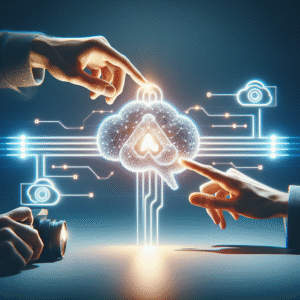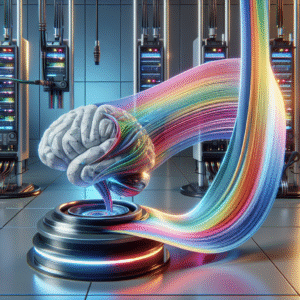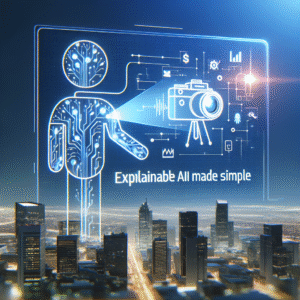Empowering the Future: A Friendly Guide to Building Your Own AI Agent with the Right Tools
Table of Contents
- 1. Introduction
- 2. Understanding AI Agents
- 3. Essential Tools for Building AI Agents
- 4. Designing Your AI Agent
- 5. Data Collection and Preparation
- 6. Training Your AI Agent
- 7. Testing and Evaluation
- 8. Deployment Strategies
- 9. Real-World Applications of AI Agents
- 10. Future Trends in AI Agents
- 11. Conclusion
1. Introduction
Welcome to the fascinating world of artificial intelligence (AI)! What was once just a figment of our imaginations is now an everyday reality. Among the most thrilling advancements in this field are AI agents—those nifty programs that can take charge, make decisions, and even chat with us like a friend. As we stand at the cusp of what many folks are calling the AI revolution, knowing how to create these agents can really give you a leg up, whether you’re an individual or a business.
According to a recent study by Statista, the global AI market is forecasted to hit an incredible $390.9 billion by 2025. That’s a huge jump, and it shows just how much demand there is for people who can craft AI solutions, including those clever little agents. So, how can you get started building your own AI agent? This guide is here to break it all down for you in a way that’s easy to understand.
From grasping the basic concepts to picking the right tools, designing algorithms, and finally deploying your AI agent, each step is super important. Whether you’re a seasoned developer wanting to broaden your skills or just someone curious about AI, this guide will arm you with the essential know-how to kick off this exciting journey.
2. Understanding AI Agents
Before we roll up our sleeves and get into the nitty-gritty of building AI agents, let’s make sure we’re on the same page about what they really are and how they work. An AI agent is basically a piece of software that interacts with its environment and takes actions to reach specific goals. These agents can range from simple, rule-based systems to sophisticated entities that learn and evolve using cutting-edge machine learning techniques.
2.1 Types of AI Agents
AI agents come in various flavors, based on their features and how they learn:
- Reactive Agents: Think of these as the straightforward types. They react to the current state of their environment without remembering the past.
- Deliberative Agents: These clever ones can plan and make decisions based on their understanding of their environment, allowing them to anticipate the outcomes of their actions.
- Learning Agents: Using machine learning techniques, these agents get smarter over time as they gain experience and process more data.
2.2 Key Components of AI Agents
To design and implement an effective AI agent, it’s crucial to know its main components:
- Perception: This is all about how the agent senses its environment and collects data.
- Action: This is where the agent takes action based on the information it gathers.
- Environment: The setting where the agent operates and interacts with other elements.
- Goal: The objectives the agent strives to achieve through its actions.
2.3 The Role of AI Agents in Society
AI agents are becoming indispensable in various fields like healthcare, finance, and customer service. They help automate boring tasks, improve decision-making, and even offer personalized experiences. Just think about virtual assistants like Siri and Alexa—they’re perfect examples of AI agents making our daily lives easier and showcasing the potential of this technology.
3. Essential Tools for Building AI Agents
Now that we’ve got a good grasp of what AI agents are, let’s dive into the tools you’ll need to build them. Thankfully, there are tons of frameworks and libraries designed to simplify the development of AI solutions.
3.1 Programming Languages
The programming language you choose can really shape your development experience. Here are some of the most popular languages when it comes to AI:
- Python: Known for being user-friendly and flexible, Python boasts a rich ecosystem with libraries like TensorFlow, PyTorch, and scikit-learn, making it a go-to for AI projects.
- Java: Java’s reliability and portability make it perfect for large-scale AI applications, with libraries like Weka and Deeplearning4j that come in handy for machine learning.
- R: If you’re into stats, R is your best buddy. It’s great for data manipulation and is widely used in academic circles for AI research.
3.2 Machine Learning Frameworks
Machine learning frameworks are your best friends for building, training, and deploying AI models with ease. Here are a few popular ones:
- TensorFlow: Created by Google, TensorFlow is an open-source framework that’s great for deep learning and neural network modeling.
- PyTorch: Known for its flexibility and dynamic computation graph, PyTorch is a favorite among researchers keen on developing innovative AI models.
- Keras: This high-level neural networks API simplifies the process of building complex deep learning models.
3.3 Development Environments
Setting up the right development environment is key to success in AI projects. Some popular choices include:
- Jupyter Notebook: An interactive playground for sharing code and visualizing data, perfect for data analysis and experimentation.
- Google Colab: A cloud-based platform offering free access to GPU resources, making it easy to run machine learning experiments without needing fancy hardware.
- Integrated Development Environments (IDEs): IDEs like PyCharm and Visual Studio Code provide robust coding, debugging, and project management features.
4. Designing Your AI Agent
With your toolkit ready, it’s time to design your AI agent! This phase is all about sketching out the architecture, defining functionalities, and deciding how your agent will interact with users or other systems.
4.1 Defining Objectives and Use Cases
Before you dive into the design, you need to nail down what your AI agent is supposed to achieve. Consider these questions:
- What specific tasks will your agent handle?
- Who will be using it, and what are their needs?
- How will the agent interact with users or other systems?
By answering these questions, you’ll create a focused design that meets user expectations and aligns with your goals.
4.2 Architecture Design
The architecture of your AI agent generally consists of several layers, including:
- Data Layer: This part manages data input, storage, and retrieval.
- Processing Layer: This is where the magic happens, with core logic and algorithms processing data and making decisions.
- Interface Layer: This layer facilitates communication between the agent and its users, be it through text, voice, or graphical interfaces.
4.3 Interaction Design
How users will interact with your AI agent is a big deal for its success. This includes defining user interfaces, chatbot dialogues, or voice commands. Here are some key points to keep in mind:
- Make sure the interaction is intuitive and user-friendly.
- Include feedback mechanisms to enhance user experience.
- Test various interaction scenarios to optimize performance.
5. Data Collection and Preparation
Data is the backbone of AI agents. The effectiveness of your agent hinges on the quality and quantity of the data it learns from. This section delves into ways to collect data and prepare it for training.
5.1 Data Sources
Finding the right data sources is your first step. Here are some options:
- Public Datasets: Plenty of open datasets are available across different domains, like those found on Kaggle, UCI Machine Learning Repository, and government sites.
- Surveys and User Inputs: Gathering data directly from users through surveys or feedback forms can yield valuable insights.
- Web Scraping: Automated tools can pull data from websites, but remember to follow legal and ethical guidelines.
5.2 Data Cleaning
Raw data often comes with its fair share of messiness. Data cleaning is all about:
- Removing duplicates and irrelevant entries.
- Addressing missing values by either filling them in or getting rid of them.
- Normalizing or standardizing data to maintain uniformity.
5.3 Data Annotation
If you’re looking into supervised learning, having labeled data is key. Data annotation involves tagging data with the right labels, so your AI agent can learn from examples. This can be done manually or by using automated tools, depending on how tricky the task is.
6. Training Your AI Agent
Training is where your AI agent learns from the data you’ve prepared. This critical phase directly impacts how well the agent performs.
6.1 Selecting the Right Algorithm
The algorithm you choose should fit the nature of your problem. Here are some common ones used in AI training:
- Supervised Learning: Algorithms like linear regression, decision trees, and neural networks are perfect for tasks with labeled data.
- Unsupervised Learning: Techniques like clustering and dimensionality reduction work wonders when you’re dealing with unlabeled data.
- Reinforcement Learning: This approach is great for agents that need to learn optimal actions through trial and error in ever-changing environments.
6.2 Model Training and Validation
After picking your algorithm, it’s time to train the model with your prepared data. Key steps include:
- Splitting your dataset into training and validation sets to assess performance.
- Monitoring metrics like accuracy, precision, and recall during training.
- Tuning hyperparameters to fine-tune model performance.
6.3 Continuous Learning
Your AI agents should be built to learn and adapt as time goes on. Implementing continuous learning helps agents refine their performance based on fresh data and experiences. Techniques like transfer learning can help speed things up by utilizing existing models.
7. Testing and Evaluation
Thorough testing is a must to ensure your AI agent works as intended. This phase involves evaluating its performance and making any necessary tweaks before deployment.
7.1 Performance Metrics
Setting clear performance metrics is crucial for measuring how effective your AI agent is. Common metrics include:
- Accuracy: How often the agent makes correct predictions.
- F1 Score: This balances precision and recall, which is especially handy for imbalanced datasets.
- Confusion Matrix: A handy tool for visualizing how well your classification model is performing.
7.2 User Testing
User testing gives you golden insights into how usable and effective your agent is. It’s the time for real users to interact with the agent and share their experiences. This feedback is invaluable for spotting areas that need improvement and ensuring the agent meets user needs.
7.3 Iteration and Refinement
Based on testing results and user feedback, it’s time to tweak and refine your AI agent. Continual improvement is crucial for addressing any issues and boosting overall performance.
8. Deployment Strategies
The last step in your AI agent journey is deployment. This is all about making your agent available for folks to use and ensuring it works reliably in the real world.
8.1 Deployment Environments
AI agents can be deployed in a variety of settings, including:
- Cloud: Cloud platforms like AWS, Azure, and Google Cloud offer great scalability and flexibility for your AI applications.
- On-Premises: For those with strict data privacy needs, deploying on local servers might be the way to go.
- Edge Devices: Placing AI agents on edge devices allows for real-time processing and lower latency, which is great for IoT applications.
8.2 Monitoring and Maintenance
After deployment, it’s essential to keep an eye on your AI agent to ensure it performs as expected. Regular maintenance should include:
- Updating models with new data to boost accuracy.
- Fixing any bugs or performance hiccups that pop up.
- Iterating based on user feedback to improve functionality.
8.3 Scaling Your AI Agent
As your user base grows, you might need to scale your AI agent. Strategies for scaling include optimizing algorithms, enhancing infrastructure, and using cloud resources to manage increased demand.
9. Real-World Applications of AI Agents
AI agents are making waves in many industries, proving their versatility and potential. Here are some standout examples:
9.1 Customer Service
AI chatbots are changing the game in customer service by offering instant responses, handling multiple inquiries at once, and cutting down wait times. Companies like Zendesk and Intercom are leveraging AI agents to boost customer engagement and satisfaction.
9.2 Healthcare
In the healthcare sector, AI agents assist with diagnosing ailments, recommending treatments, and managing patient information. Systems like IBM Watson delve into mountains of medical literature and patient records to provide insightful recommendations for doctors.
9.3 Finance
In finance, AI agents are employed for fraud detection, risk assessment, and investment management. Platforms like Betterment and Wealthfront use AI algorithms to optimize investment strategies, helping clients get better returns.
10. Future Trends in AI Agents
The world of AI is ever-changing, and several trends are paving the way for the future of AI agents:
10.1 Increased Personalization
As AI agents become more advanced, personalization will take center stage. Agents will analyze user data to tailor interactions and suggestions, making experiences even better.
10.2 Greater Collaboration with Humans
AI agents are increasingly designed to work alongside humans, augmenting rather than replacing human capabilities. This collaborative approach can lead to smarter decision-making and boosted productivity.
10.3 Ethical AI Development
As AI tech progresses, ethical considerations will be more important than ever. Ensuring fairness, transparency, and accountability in AI agents will be vital for building trust with users.
11. Conclusion
Building your own AI agent with the right tools is an exciting endeavor that opens doors to countless possibilities across various sectors. From grasping foundational concepts to selecting the right tools, designing, training, and deploying your agent, each step deserves careful thought and planning. As the demand for AI solutions skyrockets, gaining the skills to build these agents can put you or your organization at the forefront of the AI revolution.
As you set off on your adventure to create your own AI agent, keep your curiosity alive, experiment with different tools and techniques, and strive for continuous improvement. The future of AI is bright, and those who engage with it will play a crucial role in shaping what’s to come.
So, are you ready to dive in? Start exploring the tools mentioned in this guide and take the first step towards building your AI agent today!






